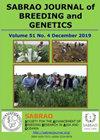乌兹别克斯坦中部地区棉花种子发芽的科学依据
IF 1.7
Q3 PLANT SCIENCES
引用次数: 0
摘要
棉花(Gossypium hirsutum L.)种子对萌发的响应取决于从萌发到出苗过程中种子环境条件对萌发和幼苗发育的促进作用。温度和基因型可以影响陆地棉的幼苗活力,并有助于确定在不同极端温度下表现良好的有前途的基因型。在本研究中,棉花种子发育的性质在很大程度上取决于温度条件和生长季节,这提供了基于萌发热状态决定其均匀性的信息。棉花种子的物理和生物多样性与植物发育模式及某些环境因子对其的影响密切相关。在本研究中,3个当地棉花品种AN-Bayaut-2、Tashkent-6和Armugon-2在2个日期(4月17日和5月10日)播种。棉花种子发育的性质在很大程度上取决于温度和生长季节以及萌发时的热状态,表现出不同的指标。一项发现表明,在播种较晚的地区,种子的发芽率降低。在萌发能等生理功能方面,以植物发育中下部的种子效果最好。与当地棉花品种塔什干6号和阿穆贡2号相比,安-巴约2号根据种子萌发和植被期对各种环境因子的适应能力较强。本文章由计算机程序翻译,如有差异,请以英文原文为准。
SCIENTIFIC BASIS OF COTTON SEED GERMINATION IN THE CENTRAL REGION OF UZBEKISTAN
The responses of cotton (Gossypium hirsutum L.) seeds to germination depend upon the point in the germination-through-emergence sequence at which seed environmental conditions conclude to promote germination and seedling development. Temperature and genotype can influence seedling vigor in upland cotton and help identify promising genotypes that could perform well under different temperature extremes. In the presented research, the nature of the development of cotton seeds largely depends on temperature conditions and the growing seasons, which provide information that determines their uniformity based on the thermal regime of germination. The physical and biological diversity of cotton seeds has close relations to the pattern of plant development and the influence of certain environmental factors on them. In the presented study, sowing seeds of three local cotton cultivars, AN-Bayaut-2, Tashkent-6, and Armugon-2, transpired on two dates (April 17 and May 10). The nature of cotton seeds’ development, largely dependent on temperature and growing season and on the thermal regime of their germination, showed different indicators. A discovery revealed that the germination of seeds decreased in areas with later-sown kernels. In terms of germination energy and other physiological functions, the best results were notable in seeds at the lower and middle stages of plant development. The cultivar AN-Bayaut-2 is adaptable to various environmental factors according to seed germination and vegetation period compared with other local cotton varieties, i.e., Tashkent-6 and Armugon-2.
求助全文
通过发布文献求助,成功后即可免费获取论文全文。
去求助
来源期刊

Sabrao Journal of Breeding and Genetics
农林科学-奶制品与动物科学
CiteScore
1.90
自引率
50.00%
发文量
63
期刊介绍:
The SABRAO Journal of Breeding and Genetics is an international journal of plant breeding and genetics research and was first published in 1969. It is the official publication of the Society for the Advancement of Breeding Research in Asia and Oceania (SABRAO).
Its objectives are to: promote the international exchange of research information on plant breeding and genetics, by describing new research findings, or ideas of a basic or practical nature; and be a medium for the exchange of ideas and news regarding members of the Society.
The Journal gives priority to articles that are of direct relevance to plant breeders and with emphasis on the Asian region. Invited for publication are research articles, short communications, methods, reviews, commentaries, and opinion articles. Scientific contributions are refereed and edited to international standards.
The journal publishes articles for SABRAO members mainly. The Journal preferred strongly that at least one author should be a current member of the Society. Non-members may also publish in the journal.
 求助内容:
求助内容: 应助结果提醒方式:
应助结果提醒方式:


